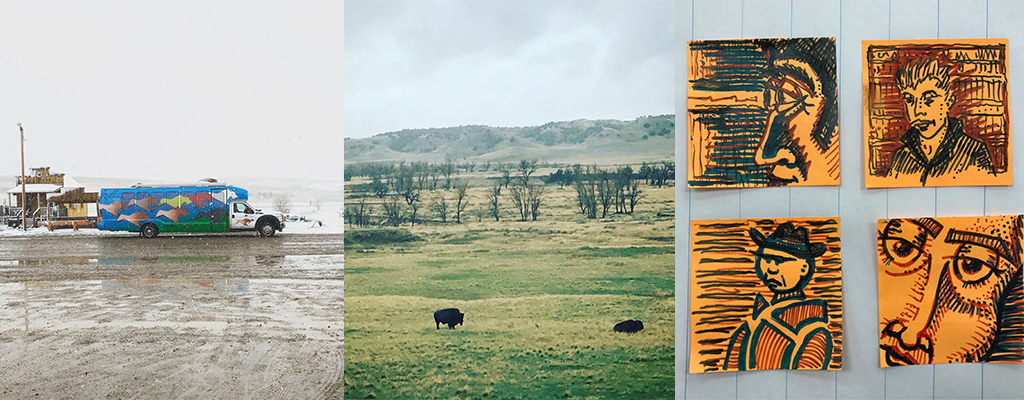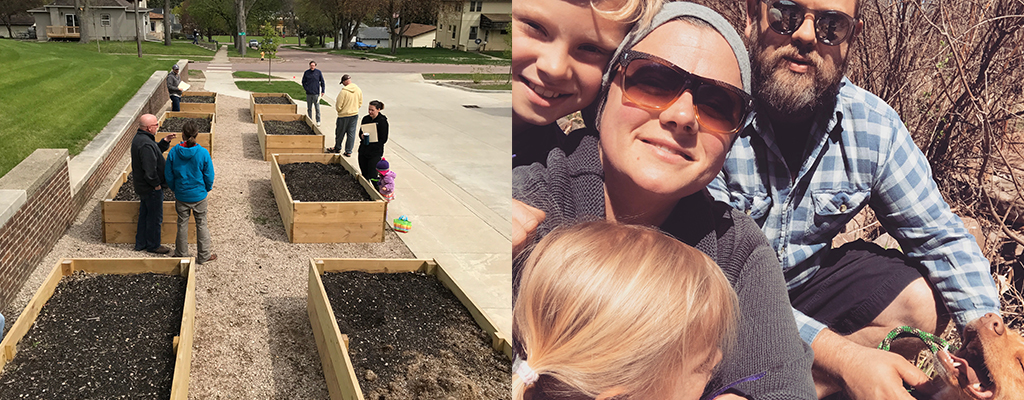A little over a year ago, Katrina Lehr-McKinney, Media Strategist / Operations at Fresh Produce, traveled across South Dakota during her month-long sabbatical. I sat down with Katrina to find out a little more about what she did while she was out of office.
Katrina spent two weeks facilitating discussions in different parts of the state, with various art communities. She was invited to fill this role by South Dakota Arts Council and Arts South Dakota to help in their strategic planning process.

“It was a crazy four weeks because I traveled so much.
Over the two weeks of traveling, I put 2000 miles on my car. It was kind of nutty. I learned so much.”
Angela: I’m so curious about how this project came about. Are you actively involved with these organizations?
Katrina: Over a decade of my life was spent in non-profit administration work. [Katrina previously worked with the Sioux Falls Jazz & Blues Society and South Dakotans for the Arts.] So, I’m still connected to a lot of these people and a lot of the things going on in the state. Jim Speirs, a former colleague, now the Executive Director of
Arts South Dakota and Patrick Baker, Director of
South Dakota Arts Council, are trying to refresh things that have been happening in the state for decades. So, when they asked me to be a part of this process, I jumped in.
A: That sounds like a pretty big undertaking. What was the end goal of the project?
K: I think especially as a state agency, it’s super hard to take a step back and attempt to refresh things. But one thing they wanted to do was to go around [the state] and have these facilitated discussions in all of these communities to see what is it that the arts council and Arts South Dakota can do for these communities, artists, organizations, schools and everything else.They’d done some regional meetings in the past but they hadn’t gone to a lot of these communities. For example, they felt it was very important to go to Eagle Butte and have a discussion because the state’s arts council was writing its strategic plan. They wanted to take objectives out of this content that they heard. They wanted to prioritize the content in such a way that they could create a strategic plan out of it.
A: How did you prep for this role? Was this something you’ve done before?
K: I was there to run the meetings, make sure there was no weird politics going on and that everyone’s voice was heard. Every community was almost a completely different conversation. So we have this saying at Fresh Produce, right? “Come on in, and make yourself uncomfortable”. Oh, this was really uncomfortable for me! I had run meetings before with work and our neighborhood association, etc. And I’ve been in situations kind of like this before, but not on this level. I really took it seriously and I met with a friend of mine who is a professional facilitator. He does this World Café facilitation process and so I learned more about that process from him. I thought a lot about how I could employ it to make sure everybody was heard and all perspectives were brought to the open. It was like homework for me — learning this process, going in and being really vulnerable but taking ownership of these meetings.
A: You mentioned “Come on in, and make yourself uncomfortable”. Were there any experiences during the facilitation that kind of threw you off?
K: It was a great experience and I would definitely do it again. There were some really great conversations and there were some really awkward conversations. And the most awkward thing was when we were in Eagle Butte which is on the Cheyenne River Reservation. What happened in Eagle Butte is that it was a room full of teenagers. I think there was a kind of misunderstanding as far as who they thought were supposed to be at this meeting. They were in this scenario where they were like, “Why are you asking us these questions?” I wasn’t prepared and I didn’t realize what it was going to be because that was my second day. I was asking them questions like, “Do you guys feel like you have enough art in your schools?” But they still wouldn’t answer my questions. So then finally, the Executive Director of the
Cheyenne River Youth Project came up and ran the meeting for me. So, that was the most uncomfortable. It was just like pulling teeth.

A: I can’t imagine what that would have been like, for you and for them. Other than Eagle Butte, what was your most significant takeaway from this facilitation process for the arts in South Dakota?
K: The next day we went to Red Cloud, which is in the Pine Ridge Reservation. I was really nervous going into that because of the previous day. We only had three or four people show up, which was our smallest group by a long shot. But, we had this awesome conversation where they opened up. We talked about why more Native American artists don’t apply for grants with the state, about the distrust and things like, “I don’t want to fill out an application in the way you present it. It doesn’t make sense to the way that I do my art. My art is my life. This is not a project.” I mean it was just like, “Holy shit, I had no idea!” It was eye-opening for everyone that was in that meeting.
A: That’s amazing and such a special experience. What else did you do during your sabbatical? Did you get time to do any of the house projects you had planned?
K: So, I drove West across the state, went to two different reservations and then the next week I went to
Leadership South Dakota, back in Pine Ridge. It was really great to be back there again from that Leadership South Dakota perspective and then ask questions like, “What is the culture and the art have to do with these things?”, because it is so holistic for a lot of people out there. So, that was kind of fun. And yes, I got a few house projects done too! We painted Oliver’s room and had a big yard sale.
The Fresh Produce Sabbatical
In order to make interesting work, you have to live an interesting life. That’s why Fresh Produce introduced a sabbatical program last year. Team members take 2-8 (depending on length of employment) consecutive weeks of paid time to work on a personal, creative, or community-focused project. In 2017, Katrina used her sabbatical to facilitate workshops for artists across South Dakota. In 2018, Kyle used his sabbatical to live in Barcelona for a month. Later this year, Brian will shoot a feature-length film.

